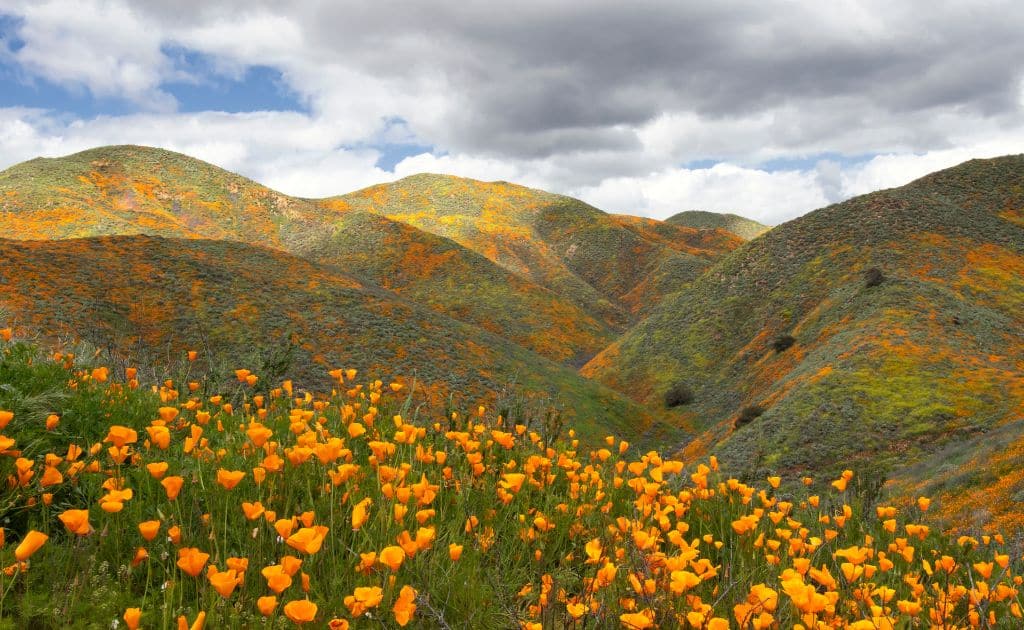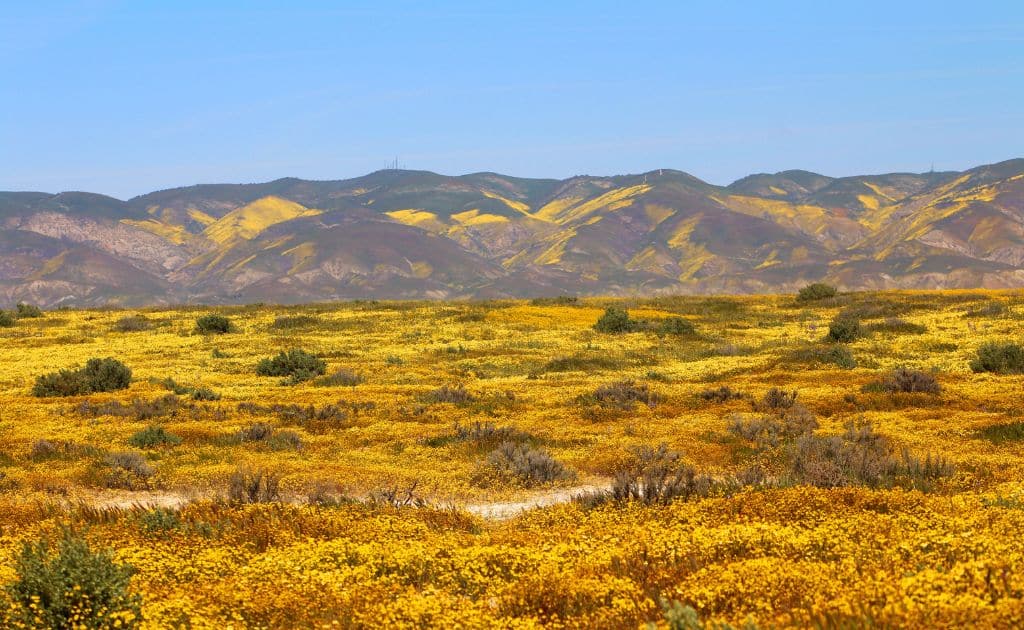How to see the 2025 California Super Bloom
Non classifié(e), Trip Ideas & Guides
Imagine walking among fields blanketed by bright oranges, yellows, and purples for as far as the eye can see. Wildflowers including California poppies, lupines, desert sunflowers, and bluebells, are growing so extensively they can be seen from space!
California Super Blooms are one of the most impressive spring phenomena the state can experience. But super blooms don’t happen every year so hopefully, your schedule is flexible if conditions align this season! With above-average rainfall throughout California over the past few months, there’s talk of another superbloom California this 2025!
What is the California Super Bloom?
The California super bloom is a rare botanical occurrence that only transpires under the right conditions. Superblooms only take place in deserts or throughout drier regions, most commonly in California, Arizona, and Nevada.

The optimal condition for a superbloom is a wet winter. A lot of rain, sometimes an overabundance, is ideal for a California super bloom. However, even with intense rain throughout the winter and early spring, a superbloom isn’t guaranteed.
Invasive grasses compete for the moisture that native flowers rely on to grow. Dormant seeds must have been spread for plants to pop up. Too much rain can carry away seeds and flowers in flash floods.
Will there be a California Super Bloom in 2025?
California superblooms are hard to predict. All the conditions have to line up perfectly. It’s hard to technically define what is considered a super bloom versus an above-average year of flowers blooming. Still, in recent years, 2017, 2019, and 2023 all had very wet autumns and winters, which created magnificent wildflower seasons.
It’s hard to predict if there will be a California wildflower super bloom in 2025; however, national and state parks say there’s a chance with the recent rains from the end of summer through winter.
The soil has consistently been moist since Hurricane Hillary hit Southern California in August 2023. This is a good reason to believe a 2025 superbloom is possible. However, wildflower seeds can lay dormant for years before germinating, so we must remain patient!
Where can I get up-to-date Superbloom Information?
Many resources, from the state and national parks to private foundations, provide California wildflowers superbloom updates.
California Department of Parks and Recreation posts regular updates for Anza-Borrego Desert State Park, Antelope Valley California Poppy Reserve, Chino Hills State Park, and a few other small viewing areas. Desert USA also posts updates for the Southern California region.

The Theodore Payne Wildflower Hotline and website provides weekly wildflower updates that are released every Friday from March through June. Check wildflower reports online or call 818-768-1802 ext 7 for a weekly recording of super bloom updates. The Theodore Payne Foundation provides updates for Southern California, including Anza Borrego Desert State Park, the Santa Monica Mountains, San Gabriel and the San Bernardino Mountains, the Santa Ana Mountains, and even Urban Los Angeles.
Death Valley National Park and Joshua Tree National Park are possible superbloom destinations in 2025. Death Valley’s national park and Instagram pages are some of the best resources to receive up-to-date information. If Joshua Tree has a superbloom, check the Instagram or iNaturalist Joshua Tree pages.
With the popularity of social media, you can now look for up-to-date photos by searching the location on Instagram.
Potential California Super Bloom Locations & Months
Given the right conditions, there are many locations throughout California where a superbloom or above-average bloom might occur in 2025. These are common locations and the time of year when blooms could possibly peak.
-
- Bay Area: Late April to mid-June
- Central California Coast: Mid-March to mid-April
- Death Valley National Park: Mid-March to mid-April
- Eastern Sierra: June and July
-
- Mojave Desert: Mid-March to early June
- Sierra Foothills: Mid-March through April
- Southern California/Mojave Desert: March to April
California Wildflowers Superbloom Etiquette and Conservation
While wildflowers can withstand harsh weather and growing conditions, they live in a dangerously fragile environment. After many environments were devastated by tourism following the 2017 wildflower superbloom many areas started to regulate wildflower viewing for the safety of the wildflowers, wildlife, locals, and visitors.
When visiting anywhere that a super bloom is expected it’s important to obey all regulations and follow the Leave No Trace Principles to reduce human impact on the environment.
- Stay on the trail. Do not walk through the flowers as this threatens future blooms and prevents wildflowers from seeding. When crowds don’t obey the rules and respect the environment the superbloom sites close.
- Do not pick wildflowers. Picking wildflowers is illegal and affects future blooms.
- Obey all road and trail closures and restrictions. Safety and traffic laws are enforced for your safety. Finding safe places to park was one of the biggest issues during previous superblooms.
- Respect wildlife. Don’t approach wildlife and remain a safe distance away. Do not feed or touch wildlife.
- Pack out all trash. This includes wrappers, paper, and anything organic including fruit peels. It’s not native to the local environment so it shouldn’t be there!
- Post photos ethically. If you choose to post photos of California wildflowers superblooms do so appropriately. Follow all rules and don’t post photos in the middle of a field, off-trail. Also, reiterate how to ethically enjoy the super bloom so that visitors can continue to appreciate the spectacular phenomenon.
California Super Bloom Tips
Use these tips to help your California wildflowers’ super bloom trip run smoothly!
- Book your campsites ASAP! Even though it’s hard to know if a super bloom will happen, and it’s even harder to predict when wildflowers will peak, try to research your camping options. It’s a good idea to reserve campsites in advance and cancel your reservation if you can’t go.
- Follow all rules and regulations regarding both established and dispersed camping. New rules have been created, and a growing number of visitors flock to super bloom locations, state and national parks, and local law enforcement. Obey closures as fines are hefty, and they’re for your safety.
- Carry cash to pay for parking. Some superbloom locations now charge for parking. If you’re visiting a national or state park, there is always an entrance fee. Smaller locations might charge for parking or require a long walk to the bloom.
- Expect crowds. The beautiful rolling fields of flowers draw a lot of visitors. Try to visit early in the day for the smallest crowds.
- Fuel up your car, and pack snacks and water! Some super bloom locations are far from services, and you might get stuck in traffic for longer than expected.
- Enjoy! Take in every moment of the impressive and rare occurrence if you’re lucky enough to experience a California superbloom!
